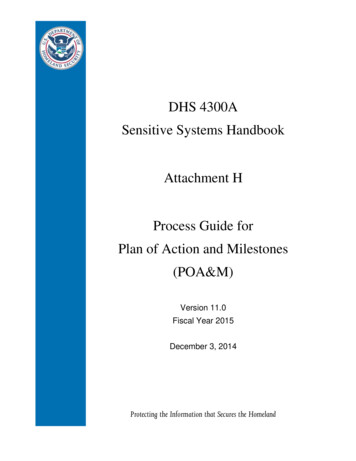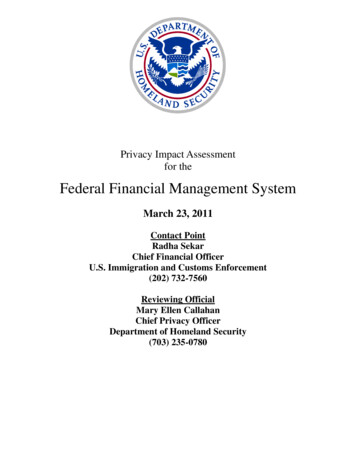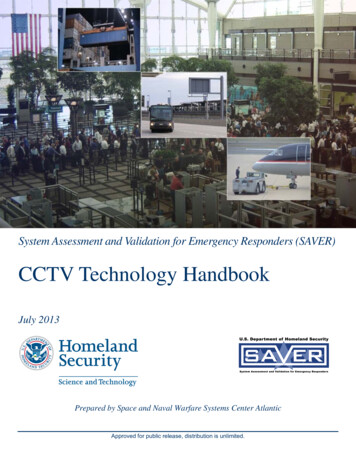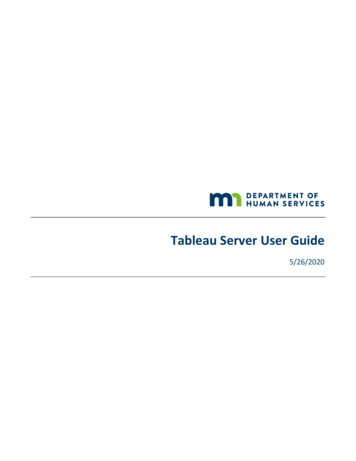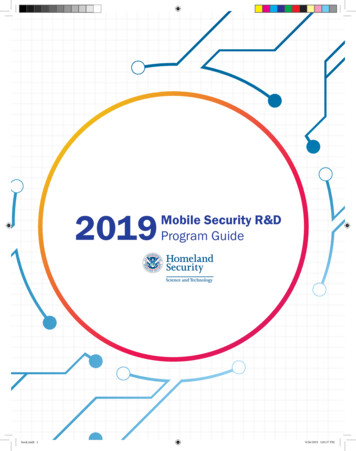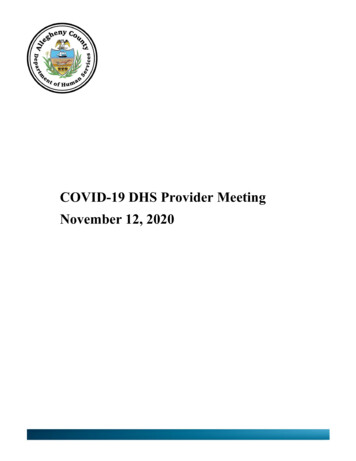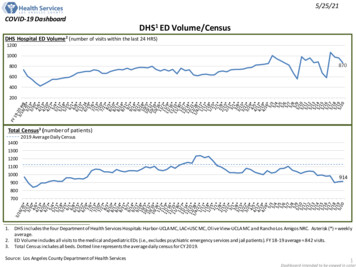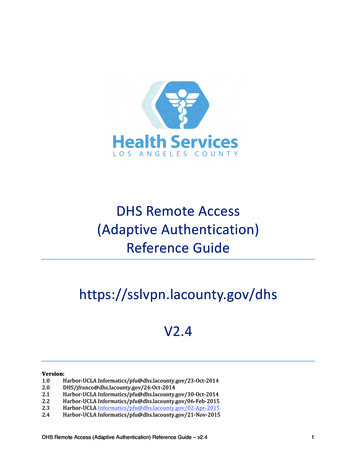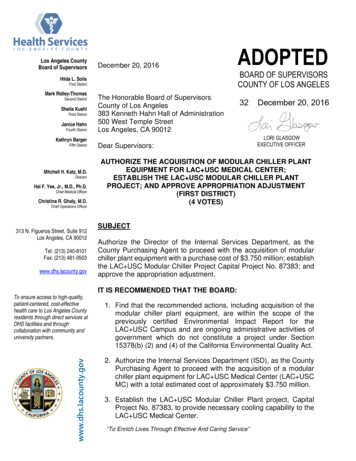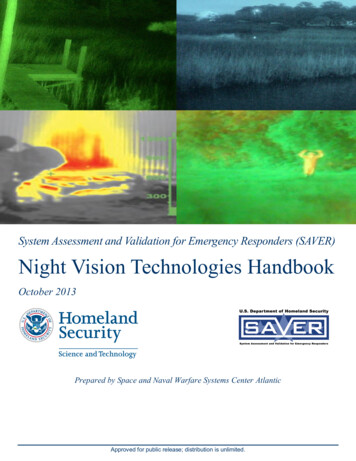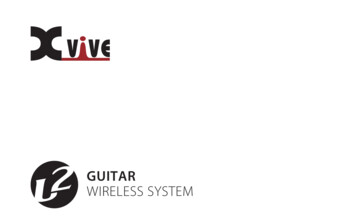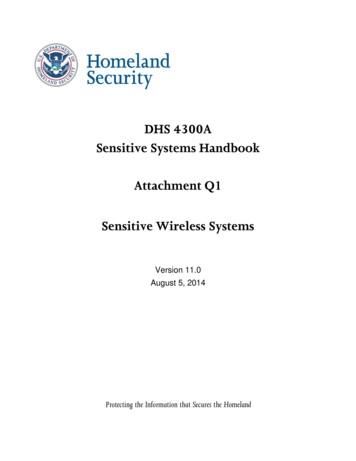
Transcription
DHS 4300ASensitive Systems HandbookAttachment Q1Sensitive Wireless SystemsVersion 11.0August 5, 2014Protecting the Information that Secures the Homeland
DHS 4300A SENSITIVE SYSTEMS HANDBOOKATTACHMENT Q1—WIRELESS SYSTEMSDocument Change HistoryVersionDateDescription1.02005Initial release2.3November 29, 2005Incorporates comments received from: ISSB, CISO, USCG3.0February 1, 2006Incremented from version 2.4 to version 3.0 due to the number ofcomments received. Version 3.0 incorporates comments from: CBP,ICE, CISO, OCIO, S&T, and USCIS.3.1February 27, 2006Incorporates comments received from WWG: CBP, FAMS, US-VISIT.3.2May 22, 2006Presented to WSB for final approval before CIO Council4.2October 1, 2006Document upgraded to version 4.2 to match 4300A policy versionscheme. Approved Q1 without revised should/shall formatting. PendingWireless Security Board final approval before sending to CISO forpublishing.4.3December 12, 2006Document upgraded to version 4.3 to reflect revised should/shallformatting. Also reflects comments received from WSB.5.0March 1, 2007No change.6.0May 14, 2008No change.6.1September 23, 2008No change.7.0August 7, 2009Introduced new terminology Authorizing Official (AO) – replaces DAA,as per NIST 800-37 and 800-5311.0August 5, 2014Rewritten as new document to reflect new wireless technologies andsecurity guidelines.v11.0 August 5, 2014ii
DHS 4300A SENSITIVE SYSTEMS HANDBOOKATTACHMENT Q1—WIRELESS SYSTEMSContents1.0INTRODUCTION . 11.1Purpose . 11.2Scope . 11.3References . 22.0SECURITY REQUIREMENTS FOR ALL WIRELESS SYSTEMS . 32.1Risk-Based Approach . 32.2Wireless System Threats and Countermeasures . 32.3Authentication. 42.4Confidentiality . 52.5Integrity . 52.6Management Control. 52.7Physical Security . 52.8National Information Assurance Partnership Common Criteria Security Validations . 52.9Logs. 62.10 Configuration Controls . 62.11 Software and Firmware Updates . 62.12 Wireless Monitoring . 62.13 Content Filtering . 62.14 Traffic Separation . 72.15 Security Assessment . 72.16 Security Incident Response . 72.17 Security Awareness Training . 73.0WLAN SECURITY GUIDELINE . 83.1Security Approach . 83.2Network Naming Conventions . 83.3ESSID Broadcasting . 83.4Access Control . 83.5Encryptions . 93.6WIDS . 93.7Wireless Intrusion Prevention Systems . 93.8Official Visitor Network . 10v11.0 August 5, 2014iii
DHS 4300A SENSITIVE SYSTEMS HANDBOOK3.9ATTACHMENT Q1—WIRELESS SYSTEMSPerimeter Security . 103.10 Radio Coverage and Power Level . 104.0FIXED ACCESS WIRELESS NETWORKS: SECURITY GUIDELINES . 114.1Bridge Link Confidentiality . 114.2Bridge Link Authentication . 114.3Bridge Radio Coverage Recommendations . 115.0WWAN: SECURITY GUIDELINES . 125.1WWAN Built-in Security Features . 125.2Private WWAN . 145.3Remote Access Through VPN Service . 146.0WIRELESS PERSONAL AREA NETWORKS: SECURITY GUIDELINES . 156.1Ad Hoc or Peer-to-Peer Networks . 156.2Devices . 156.3Coverage and Power Requirements . 156.4Bluetooth Device Communication Risks and Recommendations. 156.5Personal Identification Number Protection . 156.6Disabling Unwanted Profiles . 156.7Device Security Capabilities . 167.0INTEROPERABILITY. 177.1Interoperability governing body . 177.2Wireless System Interoperability . 177.3Wireless Standards. 17APPENDIX A – ACRONYMS . 19APPENDIX B – WLAN SYSTEM ARCHITECTURE . 23APPENDIX C – WIRELESS SYSTEM SECURITY CHECKLIST . 26APPENDIX D – WIRELESS SYSTEM RULES OF BEHAVIOR USER AGREEMENT. 32v11.0 August 5, 2014iv
DHS 4300A SENSITIVE SYSTEMS HANDBOOKATTACHMENT Q1—WIRELESS SYSTEMSThis page intentionally blankv11.0 August 5, 2014v
DHS 4300A SENSITIVE SYSTEMS HANDBOOK1.0ATTACHMENT Q1—WIRELESS SYSTEMSINTRODUCTIONWireless communications technology enables exchange of information within a geographical areaby encoding data into electromagnetic waves that propagate through space. The distances betweencommunicating locations may be millimeters or thousands of kilometers. Wireless technologies utilizevarious portions of the electromagnetic spectrum, including radio frequency (RF) and infrared (IR), bothanalog and digital wave forms, and different types of encoding, including multiplexing, channel coding,modulation, and layered communication protocols. As technology evolves, new forms of wirelesscommunications constantly emerge to meet the demands from governments, business communities, andconsumers.This document provides, from an information security perspective, techniques and procedures forimplementing wide area, local area, and personal area wireless architectures for the Department ofHomeland Security (DHS) information technology (IT) programs. Published as an attachment to the DHS4300A Sensitive Systems Handbook, this document is the foundation for DHS Components to use indeveloping and implementing their wireless IT security programs. It is based on and considers statutes;Department directives and policies; guidance from the Government Accountability Office (GAO), theNational Institute of Standards and Technology (NIST), the National Security Agency (NSA), theDepartment of Defense (DoD), and national and international standardization organizations; and generalwireless security best practices commonly recommended and followed by private industry and academiccommunities.1.1PURPOSEThis document is issued as implementation guidance for IT program managers and securitypersonnel under the authority of the DHS Chief Information Officer (CIO) through the DHS Office of theChief Information Security Officer (OCISO). This document addresses the security specifics of sensitivewireless systems only and does not cover the use of classified wireless systems. In accordance with DHSSensitive Systems Policy Directive (PD) 4300A, the use of wireless communications technologies is prohibitedwithin DHS unless the technology and the application are specifically approved by the appropriateAuthorizing Official (AO). (In accordance with NIST Special Publication (SP) 800-37, the term AuthorizingOfficial replaces the term Designated Accrediting Authority (DAA). AOs must also approve the implementation anduse of wireless systems at a specified risk level during the certification and accreditation (C&A) process andensure that appropriate and effective security measures are included in the security plan.Given the ongoing rapid evolution in wireless technology, including different technology standards andmultiple vendors’ product offerings, specific wireless systems may or may not have the ability to be madewholly compliant with the countermeasures this document outlines. The guidelines set forth in thisdocument are not intended to prohibit the use of systems that cannot meet the countermeasuresrecommended herein; the intent, rather, is to provide a detailed explanation of potential wirelessvulnerabilities and practical countermeasures in order for the Components to perform risk analysis andmake an informed decision. AOs should pay particular attention to the potential risks that must beconsidered in approving wireless systems with technological barriers that prevent the adoption of thesecountermeasures. AOs should ensure that they understand the risks associated with a particular wirelesssystem. This may include applying some but not all of the outlined countermeasures, as long as the risk ismeasured and mitigated to an acceptable level determined by the AO.1.2SCOPEWireless networks covered under this document include wireless local area networks (WLAN),wireless wide area networks (WWAN), wireless personal area networks (WPAN), peer-to-peer wirelessnetworks (i.e., ad hoc wireless networks), as well as wireless infrastructure that leverages commercialwireless services. Wireless systems include the transmission medium, stationary integrated devices, devicev11.0 August 5, 20141
DHS 4300A SENSITIVE SYSTEMS HANDBOOKATTACHMENT Q1—WIRELESS SYSTEMSfirmware, supporting services, and communication protocols. Security policies and guidelines for wirelessdevices such as smart phones will be addressed in a separated document due to the complexity and rapidtechnology development in this area. DHS Sensitive Systems Policy Directive 4300A establishes the Department’swireless systems policies and general guidelines pertaining to all wireless communications technologies.It should be noted that, with very few exceptions, almost all wireless systems are eventually connected todata packet-based wired networks that are managed by either DHS or outside third parties. While thesecurity policies of wired networks are out of the scope of this document, the guidelines set forth in thisdocument will address end-to-end as well as interface security requirements when both wireless and wirednetworks are involved.The scope and contents of this document will change over time as new capabilities are added to DHSsystems, as security standards are upgraded or created, and as a result of user experiences and comments. Asthe DHS IT wireless security programs mature, additional attachments to the DHS 4300A Sensitive SystemsHandbook that address specific areas of security interest will be developed and published.1.3REFERENCESThe following documents were reviewed and referenced for this document: DHS, DHS Sensitive Systems Policy Directive 4300A, Version 9.1, July, 2012.DHS, Wireless Local Area Network Security Reference Architecture, Version 1.0, September 19,2011.GAO, Federal Agencies Have Taken Steps to Secure Wireless Networks, but Further Actions CanMitigate Risk, November 2010.NIST SP 800-53, Revision 3, Recommended Security Controls for Federal Information Systems andOrganizations, August 2009.NIST SP 800-97, Establishing Wireless Robust Security Networks: A Guide to IEEE 802.11i,February 2007.NSA, Guidelines for the Development and Evaluation of IEEE 802.11 Intrusion Detection Systems(IDS), Version 1.1, November 2005.DoD 8420.01, Commercial Wireless Local-Area Network (WLAN) Devices, Systems, andTechnologies, November 3, 2009.IEEE, IEEE 802.11: Wireless LAN Medium Access Control (MAC) and Physical Layer (PHY)Specifications, IEEE-SA, June 12, 2007.IEEE, IEEE 802.11i-2004: Amendment 6: Medium Access Control (MAC) Security Enhancements,July 23, 2004.NIST SP 800-121, Guide to Bluetooth Security, June 2012.Wi-Fi Alliance, the State of Wi-Fi Security, January 2012.v11.0 August 5, 20142
DHS 4300A SENSITIVE SYSTEMS HANDBOOK2.0ATTACHMENT Q1—WIRELESS SYSTEMSSECURITY REQUIREMENTS FOR ALL WIRELESS SYSTEMSThe wireless security requirements listed in this section consist of a common set of core securitycapabilities and features that are applied to all wireless technologies. Requirements unique to specific typesof wireless systems (e.g., 802.11 WLAN) will be addressed in the subsequent sections. As mentionedearlier, these requirements are derived from DHS directives and policies, guidance from other governmentsources, and practices recommended and followed by private industry, academic communities, andstandardization organizations.2.1RISK-BASED APPROACHA risk-based approach to wireless system security is a system-engineering approach to identify,assess, and prioritize risks associated with wireless systems and determine the likelihood and potentialimpact of these risks. Mitigation strategies and resources are then applied in defending against the mostsignificant threats and preventing the incurrence of undue risks. For instance, unauthorized access points ordevices on the DHS internal network occur sometimes and they pose great threat to the DHS informationsecurity as the internal network is regarded as trusted and within the defense perimeter. One mitigationstrategy against this threat is to deploy effective detection and prevention tools to identify these threats andblock their access when detected. A risk-based approach shall be used to mitigate risks associated with wireless systems.At the highest level, two security classifications can be used to help identify and assess risks associated witha given wireless system: Trusted: Any combination of people, information resources, data systems, and networks that aresubject to a shared security policy (a set of rules governing access to data and services). A trustedwireless system is within the accreditation boundary established by DHS and over which DHS hasdirect control for the application of required security controls or the assessment of security controleffectiveness. Untrusted: Any combination that is outside the “trusted.” An untrusted wireless system is outsidethe accreditation boundary established by DHS and over which DHS has no direct control for theapplication of required security controls or the assessment of security control effectiveness.Commercial or official visitor wireless networks, for example, should be considered untrusted because theyare outside DHS control. DHS internal wireless networks are considered trusted because DHS can applyrigorous security policies and controls on these networks. Risks can be identified from the technology,process, and people perspectives by taking into account of the unique open nature of wireless systems andthe rapid evolution of wireless technologies. The following section describes various wireless system threatsand corresponding countermeasures in detail.2.2WIRELESS SYSTEM THREATS AND COUNTERMEASURESWireless systems have their inherent weakness and vulnerabilities due to the open nature of wirelesstechnologies, and security threats are widespread through a wide variety of attack methods. Wirelesscommunications are susceptible to interference, eavesdropping, RF jamming, as well as threats typical towired networks.Threat CategoryDenial of ServiceEavesdroppingv11.0 August 5, 2014DescriptionAttacker prevents or prohibits the normal use or management of networks or networkdevices.Attacker passively monitors network communications for data, including authenticationcredentials.3
DHS 4300A SENSITIVE SYSTEMS HANDBOOKATTACHMENT Q1—WIRELESS SYSTEMSThreat CategoryMan-in-the-MiddleMasqueradingMessage ModificationMessage ReplayTraffic AnalysisDescriptionAttacker actively intercepts the path of communications between two legitimate parties,thereby obtaining authentication credentials and data. Attacker can then masqueradeas a legitimate party. In the context of wireless systems, a man-in-the-middle attack canbe achieved through a bogus or rogue Access Point (AP), which looks like anauthorized AP to legitimate parties.Attacker impersonates an authorized user and gains certain unauthorized privileges.Attacker alters a legitimate message by deleting, adding to, changing, or reordering it.Attacker passively monitors transmissions and retransmits messages, acting as if theattacker were a legitimate user.Attacker passively monitors transmissions to identify communication patterns andparticipants, and extracts sensitive information.Table 1. Wireless System ThreatsWireless system security addresses data confidentiality and integrity, authentication and access control,intrusion detection and prevention, logging and monitoring, as well as system availability andperformance. The goal of wireless system security can be better achieved and the threats mitigated byadhering to federally-mandated standards and industry’s information security best practices.OSI LayerSecurity ConsiderationsApplicationDetect and prevent malicious code, viruses, phishing, and other malware applications. Mitigationtools include firewalls, anti-virus/malware detection software, Web security, and intrusiondetection applications.PresentationProtect data files by cryptography (e.g., file password encryption).SessionProtect system from port exploits or session hijacking. Use Secure Socket Layer (SSL) forSession and Transport layers.TransportProvide authentication and secure end-to-end communications such as the Secure Shell (SSH-2)protocol.NetworkProtect the routing and the forwarding protocols by robust authentication and encryption ofrouting data. The Internet Protocol Security (IPSec) standard provides meshed and simultaneoustunnels for secure communication.Data LinkProtect the Media Access Control (MAC) sublayer from masquerade, DoS, impersonation, andAddress Resolution Protocol (ARP) threats. Wireless protocols have built-in security featuressuch as Layer 2 tunnels and message integration check.PhysicalDetect and prevent jamming and denial of service (DoS) attacks in the air medium via wirelessintrusion detection system and intrusion prevention system (WIDS/IPS), which can detectabnormal signals and physically geolocate the suspicious devices via direction findingstriangulation and timing algorithms. Employ anti-jamming techniques such as spread spectrumtechniques.Table 2. OSI Security Considerations2.3AUTHENTICATIONAuthentication methods include IEEE 802.1X port-based network access control, Extensible AuthenticationProtocol–Transport Layer Security (EAP-TLS) authentication, and enterprise Remote(RADIUS)servers to provide mutual authentication to user devices and systems while providing for dynamic keymanagement.It should be noted that EAP-TLS requires existing Public-key Infrastructure (PKI). If a full-fledged PKI is notavailable, other authentication protocols, such as EAP-Protected Extensible Authentication Protocol (EAPPEAP), can be used. These protocols only require a server side x.509 digital certificate that can be purchasedv11.0 August 5, 20144
DHS 4300A SENSITIVE SYSTEMS HANDBOOKATTACHMENT Q1—WIRELESS SYSTEMSfrom a third-party Certificate Authority, or a digital certificate can be issued from an organization's internalCertificate Authority. No user device authentication is provided in this case. Additional network controlaccesses, such as two-factor authentication, may be required to authenticate users and devices to ensure thatthey do not introduce security vulnerabilities and risks.2.4CONFIDENTIALITYDHS PD 4300A requires that “Components shall use only cryptographic modules that are FederalInformation Processing Standard (FIPS) 197 (Advanced Encryption Standard [AES]-256) compliant andhave received FIPS 140-2 validation at the level appropriate to their intended use.”2.5INTEGRITYWireless traffic integrity is essential to ensure that data has not been modified in transit or at rest, and italso protects against other threats such as man-in-the-middle attacks. If a mechanism is available that allowsfor cryptographic verification of message integrity, system nodes must discard all messages that cannot beverified.2.6MANAGEMENT CONTROLWireless systems must be capable of supporting remote device management, establishment or change toconfigurations to comply with security policy, and updates of software and firmware. Wireless systemsmust have the ability to manage wireless infrastructure via management interfaces and tools which are partof the overall enterprise management infrastructure.The network segment for management control should be integrated into the enterprise wired network, andit should be isolated from data networks to ensure robust management control. Security protections mustnot degrade or impede critical services or usability features protected by law or published policy (forexample, compliance with Section 508 of the U.S. Rehabilitation Act).A centralized wireless management structure provides a more effective means to manage the wirelessinfrastructure and the information security program as a whole. A centralized structure can also facilitatethe development and implementation of standardized guidance, which allows organizations to consistentlyapply information security policies.Wireless devices and/or software must not degrade or circumvent established system security controls. Anysystem modifications require appropriate security review and follow change management policies andprocedures. In addition, configuration management and secure baseline configurations should be addressedin the organization’s system security plan for that system.2.7PHYSICAL SECURITYRoutine inspections and surveillance for suspicious behavior will reduce the likelihood of unauthorizedequipment operation and theft. Because wireless systems are susceptible to eavesdropping from a distance,guards and users alike should report to appropriate security personnel any suspicious individuals oractivities in or around the facility.2.8NATIONAL INFORMATION ASSURANCE PARTNERSHIP COMMON CRITERIA SECURITYVALIDATIONSThe National Information Assurance Partnership (NIAP) is a U.S. Government initiative to addressIT system and product security testing demands of both IT consumers and producers. NIAP is acollaboration of NIST and NSA to add a level of trust in IT products and networks. The Common Criteriadefine a set of validated IT requirements that can be used in establishing security requirements for productsand systems. The Common Criteria also define Protection Profiles (PP), or implementation-independentstandardized sets of security requirements based on particular needs. PPs are available for products withinthe wireless security architecture. Additionally, a Security Target (ST) can be developed to measure securitythreats, objectives requirements, and summary specifications of security functions. STs are developed forv11.0 August 5, 20145
DHS 4300A SENSITIVE SYSTEMS HANDBOOKATTACHMENT Q1—WIRELESS SYSTEMSspecific products with specifically identified targets of evaluation. The STs may or may not conform to PPsto form a basis for evaluation.When avoiding the use of processes that send clear text passwords or otherwise do not use a secureprotocol (e.g., Telnet, HyperText Transport Protocol [HTTP], Simple Network Management Protocol[SNMP] v1/2, and Cisco Discovery Protocol [CDP]), for in-band device management, a possible secureconfiguration is to encapsulate insecure protocols inside encrypted tunnels; examples include IPSec and SSLbased virtual private network (VPN).2.9LOGSLogs serve as part of the wireless network monitoring and management capabilities to ensure that wirelessnetworks are constantly monitored. They provide a traceable mechanism to record network activities anddiscover network intrusions. The integrity of logs should be protected by synchronizing the time clocks onall devices, remotely recording wireless activities and events, and enforcing strict access control for logs.2.10 CONFIGURATION CONTROLSEstablishing configuration requirements and secure baseline configurations for wireless networks anddevices can help ensure they are deployed in a secure manner in accordance with DHS security policies.Wireless systems are usually initially configured with default vendor settings that are common knowledge.These settings can include network information such as default channel or modulation specification;security information such as network name, encryption methods, pass phrases or keys; and systemsmanagement information such as administration usernames, passwords, management port numbers, anddefault application services running.2.11 SOFTWARE AND FIRMWARE UPDATESThe NIST National Vulnerability Database (NVD) “ is a comprehensive cybersecurity vulnerabilitydatabase that integrates all publicly available U.S. Government vulnerability resources and providesreferences to industry resources.” 1 When possible, the updated firmware should be tested in anonproduction environment to validate functionality before a production rollout. System audit policy andguidance is provided in DHS Sensitive Systems Policy Directive 4300A and the DHS 4300A Sensitive SystemsHandbook.2.12 WIRELESS MONITORINGWireless monitoring capabilities include tools and methods for (a) conducting site surveys and theappropriate position of antennas to minimize signal leakage, (b) detecting misconfigured clients and usingpolicy driven software or hardware solutions to ensure client devices and users comply with defined DHSwireless security policies, and (c) detecting and blocking suspicious or unauthorized activity or sources ofradio interference.Wireless intrusion detection systems (WIDS)/intrusion prevention systems (IPS) can detect networkanomalies and monitor wireless infrastructure. Anomalies may include, but are not limited to, interferencesources, abnormally high or low utilization, multiple login attempts, attack signatures, off-hour logins, andother suspicious variances from the system baseline.2.13 CONTENT FILTERINGContent filtering is the process of monitoring communications such as email and Web pages, analyzingthem for suspicious content, and preventing the delivery of suspicious content to users. A dedicated servercan be used to perform the content filtering task. For wireless systems that are internal to the organizationwired networks
Aug 05, 2014 · use of wireless systems at a specified risk level during the certification and accreditation (C&A) process and ensure that appropriate and effective security measures are included in the security plan. Given the ongoing rapid evolution in wireless
